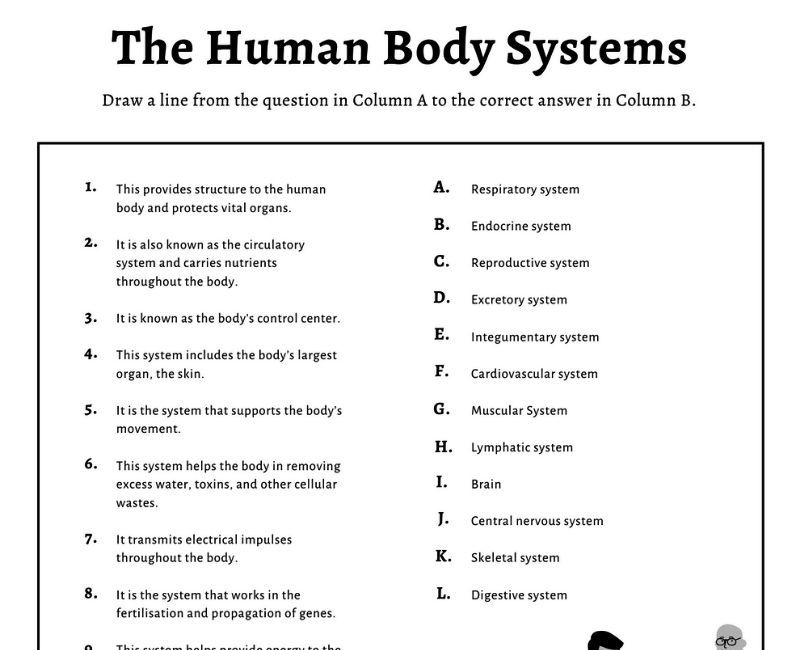Explore the Human Body With These Free Worksheets
206 Bones in the Human Body: How Many Do You Have?
The human body is an incredibly complex organism composed of many different systems that all work together to maintain a healthy state. These systems include the circulatory system, digestive system, respiratory system, musculoskeletal system and nervous system. Each system has its own unique components and functions which are essential for the health of the body as a whole.
The human body is a complex machine with numerous parts and systems that work together to keep us alive and healthy. Understanding the intricacies of the human body can be challenging, but worksheets can help make it easier. These worksheets are designed to teach students about the different parts of the body, how they work, and how they are connected. They cover a variety of topics, including bones, muscles, organs, and body systems.
One of the most fundamental aspects of the human body is the skeletal system. This system consists of bones, cartilage, and ligaments, and it serves as the foundation for the body's shape and movement. A human adult has 206 bones, and each bone has a specific function. A human body worksheet can help students learn about the different bones in the body, their names, and their functions.
Another important system in the human body is the muscular system. Muscles work in conjunction with the skeletal system to create movement and help maintain posture. There are over 600 muscles in the human body, and they come in various shapes and sizes. A human body worksheet can teach students about the different types of muscles, how they work, and how they are connected to bones.
The human body also has many vital organs that perform specific functions. The heart, lungs, liver, and kidneys are just a few examples of these organs. A human body worksheet can help students learn about the different organs in the body, what they do, and how they are connected to the body's systems.
In addition to teaching about specific parts of the body, worksheets can also help students understand how the body's systems work together. For example, the respiratory system and circulatory system work together to transport oxygen and nutrients throughout the body. A human body worksheet can teach students about the different systems in the body and how they work together to keep us healthy.
Worksheets are a valuable resource for teaching about the human body because they allow students to learn at their own pace and reinforce important concepts. They can be used in the classroom or at home as part of a larger lesson plan. Additionally, many human body worksheets are available in PDF format, making them easy to print and distribute.
Overall, human body worksheets are an excellent tool for teaching students about the complexities of the body. They can help students learn about bones, muscles, organs, and body systems, and how they work together to keep us healthy. Whether you are a teacher looking for classroom resources or a parent looking for educational materials for your child, human body worksheets are a great way to promote learning and understanding.
FAQs
Q: What is the human body made of? A: The human body is made up of trillions of cells, tissues, and organs that work together to perform various functions. The major components of the human body include bones, muscles, organs, tissues, blood, and other bodily fluids.
Q: How many bones are in the human body? A: The human body has 206 bones.
Q: What are the major organs of the human body? A: The major organs of the human body include the brain, heart, lungs, liver, kidneys, stomach, and intestines.
Q: How do the organs in the human body work together? A: The organs in the human body work together to perform various functions that keep us alive and healthy. For example, the heart pumps blood throughout the body, while the lungs take in oxygen and release carbon dioxide.
Q: What are the different systems of the human body? A: The human body has 11 major systems, which include the respiratory system, circulatory system, digestive system, nervous system, skeletal system, muscular system, urinary system, endocrine system, lymphatic system, integumentary system, and reproductive system.
Q: How can I learn more about the human body? A: There are many resources available to learn more about the human body, including textbooks, online courses, documentaries, and interactive tools such as anatomy apps and games. Worksheets and lesson plans are also available for teachers and parents to use in educating children about the human body.
Q: What are some common health issues related to the human body? A: Some common health issues related to the human body include heart disease, diabetes, cancer, respiratory illnesses, and mental health disorders. Maintaining a healthy diet, exercising regularly, and seeking medical attention when needed are important for preventing and managing these conditions.
Q: How many body parts?
A: It is difficult to give an exact number for how many parts make up the human body, as it depends on how you define "part." However, in general, the human body can be divided into several main categories of parts, including:
Organs: There are many organs in the human body, including the heart, lungs, liver, and kidneys.
Bones: There are 206 bones in the human body, which form the framework that supports and protects our organs and tissues.
Muscles: There are over 600 muscles in the human body, which allow us to move and perform various functions.
Tissues: There are four main types of tissues in the human body: epithelial, connective, muscle, and nervous.
Systems: The human body can also be divided into various systems, such as the digestive system, respiratory system, and circulatory system, each of which includes several parts that work together to perform specific functions.






